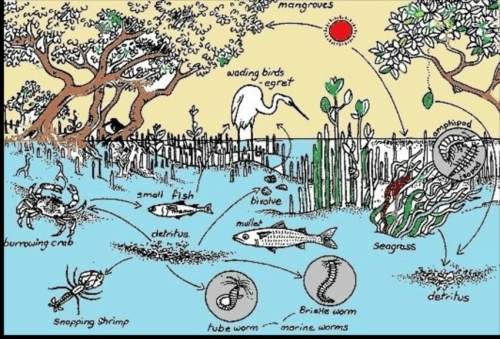
Biology, 08.09.2021 17:30 mimithurmond03
1) Base your question below on the geologic cross section shown below, which
shows a view of rock layers at Earth's surface. The dashed lines connected points
of the same age. Major fossils contained within each rock layer are shown. The
valleys are labeled X, Y, and Z. In which type of environment were the sediments
that formed these sedimentary rock layers most likely deposited?
Location 1
Location 2
Location 3
Valley
Valley
Metamorphic basement rocks
O A. Glacial
O B. Mountainous
O C. Marine
O D. Terrestrial Plateau
O E. I don't know

Answers: 2


Another question on Biology

Biology, 22.06.2019 03:30
What does the hardy-weinberg principle relate to? a. chances of survival of an organism b. frequency of alleles in a population c. natural selection in a species d. causes of evolution among organisms
Answers: 1

Biology, 22.06.2019 03:30
Students in biology are studying the macromolecules of life. they used a calorimeter to determine the calories in various types of food. once the lab was completed, the students ate the left over food samples. monica commented that in just 6 or 7 "chews" of the saltine, it was gone; nothing but a sticky paste in her mouth. elaborate on what happened chemically while chewing the saltine. include the macromolecules present.
Answers: 1

Biology, 22.06.2019 04:00
Select the correct answer. which mutation is harmful to the organism? a. a mutation allowing moths to camouflage better on blackened tree bark b. a mutation making staphylococcus aureus resistant to the antibiotic methicillin c. a mutation inhibiting human immunodeficiency virus from attaching to and entering the cell d. a mutation causing uncontrolled cell division e. a mutation giving plant leaves a bitter taste to discourage herbivores from eating them
Answers: 1

Biology, 22.06.2019 10:30
Subduction zones form when an oceanic plate collides with another oceanic plate or continental plate. the continental crust is lighter and less dense than oceanic crust. continental crust's density is approximately 2.7 grams per cubic centimeter. oceanic crust is thinner and the average density is about 3.3 cubic centimeters. when the two crustal plates converge the oceanic plate always bends and subducts beneath a continental plate. once the oceanic crust subjects, the rocks are subjected to changes in heat and pressure. because of this, we would expect to find rocks in the area of a subduction. a) clastic b) igneous c) metamorphic d) sedimentary
Answers: 2
You know the right answer?
1) Base your question below on the geologic cross section shown below, which
shows a view of rock...
Questions




Mathematics, 06.04.2020 22:42

Mathematics, 06.04.2020 22:42

English, 06.04.2020 22:42





Social Studies, 06.04.2020 22:42

Biology, 06.04.2020 22:42


History, 06.04.2020 22:42

Mathematics, 06.04.2020 22:42

Health, 06.04.2020 22:42

Biology, 06.04.2020 22:42


Mathematics, 06.04.2020 22:42





